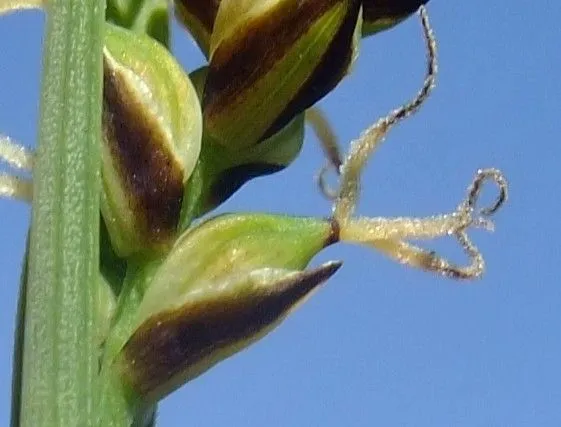
Author: L.
Bibliography: Sp. Pl.: 977 (1753)
Year: 1753
Status: accepted
Rank: species
Genus: Carex
Vegetable: Unknown
Observations: Greenland, Europe to C. Asia, Morocco
Carex panicea, commonly known as Carnat tong-grass, is a notable species within the Cyperaceae family. First described by Linnaeus in 1753 in Species Plantarum, this plant has garnered attention for its widespread distribution and distinctive characteristics.
This perennial sedge is found across a diverse range of habitats stretching from Greenland, throughout Europe, extending to Central Asia, and even reaching down to the landscapes of Morocco. Such an extensive geographical footprint speaks to the plant’s adaptability and ecological significance.
Typically growing in moist, nutrient-rich environments such as wetlands, bogs, and damp meadows, Carex panicea can be recognized by its slender, grass-like appearance. The foliage is often a striking blue-green, which can add a vibrant touch to the natural tapestry of the areas it inhabits. The plant forms dense clumps, which are beneficial in preventing soil erosion and fostering a microhabitat for various species.
The inflorescences of Carnat tong-grass are equally noteworthy. It produces compact, spike-like clusters of flowers, which are characteristically less showy but highly functional in their ecological roles, facilitating the reproductive cycle that ensures its persistent propagation in native areas.
As with many members of the Cyperaceae family, Carex panicea plays a critical role in its ecosystem, providing essential habitat and food resources for a multitude of wildlife species. Its presence often indicates healthy, well-maintained wetland regions.
In summary, Carnat tong-grass (Carex panicea) is a versatile and ecologically significant plant that thrives in a variety of moist environments across several continents. Its distinctive blue-green foliage and compact flower clusters make it an important player in maintaining biodiversity and ecosystem health.
Eng: grass-like sedge, carnat tong-grass, carnation sedge, millet sedge, pink-leaved sedge
Deu: hirse-segge, hirsen-segge, hirsensegge
Dan: hirse-star
Nld: blauwe zegge
Fin: hirssisara
Swe: hirssisara, hirsstarr
Nob: kornstarr
Nno: kornstorr
Fra: laîche bleuâtre, carex faux-millet, laîche faux-panic
Nor: pløj-skjæne, pløj-star
Sme: gordnelukti
Cym: hesg llwydlas, hesgen benigen-ddail, hesgen lwydlas
En: Carnat tong-grass, Carnation sedge, Grass-like sedge, Millet sedge, Pink-leaved sedge, Carnation Grass, Grasslike Sedge
Bg: Просена острица
Cs: Ostřice prosová
Da: Hirse-Star
Nl: Blauwe zegge
Et: Hirsstarn
Fi: Hirssisara
Fr: Laîche bleuâtre, Carex faux-millet, Laîche faux-panic, Laiche bleuâtre, Laiche faux panic, Laîche faux panic, Faux Fenouil, Laîche millet
De: Hirse-Segge, Hirsensegge, Hirsen-Segge, Fennichsegge
Hu: Muharsás
Is: Belgjastör
It: Carice migliacea
Lv: Sēres grīslis
Lt: Viksva trainė
Se: Gordnelukti
No: Pløj-skjæne, Pløj-star
Nb: Kornstarr
Nn: Kornstorr
Fa: کارکس پانیسیا
Pl: Turzyca prosowata
Ru: Осока просяная
Sv: Hirsstarr, Hirssisara
Uk: Осока просовидна
Cy: Hesgen lwydlas, Hesg Llwydlas, Hesgen Benigen-Ddail
Taken Jul 10, 2015 by Tela Botanica − Yoan MARTIN (cc-by-sa)
Taken Jul 10, 2015 by Tela Botanica − Yoan MARTIN (cc-by-sa)
Taken Jul 10, 2015 by Tela Botanica − Yoan MARTIN (cc-by-sa)
Taken Jul 10, 2015 by Tela Botanica − Yoan MARTIN (cc-by-sa)
Taken Jul 10, 2015 by Tela Botanica − Yoan MARTIN (cc-by-sa)
Taken Jun 30, 2016 by Tela Botanica − Florent BECK (cc-by-sa)
Taken Jun 30, 2016 by Tela Botanica − Florent BECK (cc-by-sa)
Taken Jun 30, 2016 by Tela Botanica − Florent BECK (cc-by-sa)
Taken Jun 30, 2016 by Tela Botanica − Florent BECK (cc-by-sa)
Taken Jun 30, 2016 by Tela Botanica − Florent BECK (cc-by-sa)
Taken Apr 19, 2017 by Yoan MARTIN (cc-by-sa)
Taken Jul 10, 2015 by Tela Botanica − Yoan MARTIN (cc-by-sa)
Taken Apr 19, 2017 by Yoan MARTIN (cc-by-sa)
Taken May 27, 2022 by Tristan Jaton-Maria (cc-by-sa)
Taken Apr 19, 2017 by Yoan MARTIN (cc-by-sa)
Taken Jun 22, 2019 by Rik Waenink (cc-by-sa)
Taken Jun 24, 2021 by Groupe Botanique de Bruxelles (cc-by-sa)
Taken Jul 13, 2020 by Groupe Botanique de Bruxelles (cc-by-sa)
Taken Jul 28, 2015 by Tela Botanica − David MERCIER (cc-by-sa)
Taken Oct 14, 2022 by Rose McTavish (cc-by-sa)
Taken May 5, 2007 by Martin Bishop (cc-by-sa)
Taken Apr 19, 2017 by Yoan MARTIN (cc-by-sa)
Taken Aug 15, 2008 by Photoflora – Benoit BOCK (©)
Taken May 22, 2019 by Tela Botanica − Florent Beck (cc-by-sa)
Taken May 31, 1851 by Tela Botanica − Herbier PONTARLIER-MARICHAL (cc-by-sa)
Taken Jan 1, 1970 by Photoflora – L’Abbé COSTE (©)
Taken Jan 1, 1900 by EOL − Encyclopedia of Life (cc-by-nc-sa)
Family: Myrtaceae Author: (F.Muell.) K.D.Hill & L.A.S.Johnson Bibliography: Telopea 6: 402 (1995) Year: 1995 Status:…
Family: Rubiaceae Author: Pierre ex A.Froehner Bibliography: Notizbl. Bot. Gart. Berlin-Dahlem 1: 237 (1897) Year:…
Family: Sapindaceae Author: Koidz. Bibliography: J. Coll. Sci. Imp. Univ. Tokyo 32(1): 38 (1911) Year:…
Family: Asteraceae Author: A.Gray Bibliography: Pacif. Railr. Rep.: 107 (1857) Year: 1857 Status: accepted Rank:…
Family: Fabaceae Author: Medik. Bibliography: Vorles. Churpfälz. Phys.-Ökon. Ges. 2: 398 (1787) Year: 1787 Status:…
Family: Aspleniaceae Author: (Cav.) Alston Bibliography: Bull. Misc. Inform. Kew 1932: 309 (1932) Year: 1932…